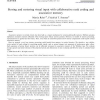Free Online Productivity Tools
i2Speak
i2Symbol
i2OCR
iTex2Img
iWeb2Print
iWeb2Shot
i2Type
iPdf2Split
iPdf2Merge
i2Bopomofo
i2Arabic
i2Style
i2Image
i2PDF
iLatex2Rtf
Sci2ools
137
click to vote
IJON
2006
2006
Storing and restoring visual input with collaborative rank coding and associative memory
Associative memory in cortical circuits has been held as a major mechanism for content-addressable memory. Hebbian synapses implement associative memory efficiently when storing sparse binary activity patterns. However, in models of sensory processing, representations are graded and not binary. Thus, it has been an unresolved question how sensory computation could exploit cortical associative memory. Here we propose a way how sensory processing could benefit from memory in cortical circuitry. We describe a new collaborative method of rank coding for converting graded stimuli, such as natural images, into sequences of synchronous spike volleys. Such sequences of sparse binary patterns can be efficiently processed in associative memory of the Willshaw type. We evaluate storage capacity and noise tolerance of the proposed system and demonstrate its use in cleanup and fill-in for noisy or occluded visual input. r 2006 Elsevier B.V. All rights reserved.
| Added | 13 Dec 2010 |
| Updated | 13 Dec 2010 |
| Type | Journal |
| Year | 2006 |
| Where | IJON |
| Authors | Martin Rehn, Friedrich T. Sommer |
Comments (0)

